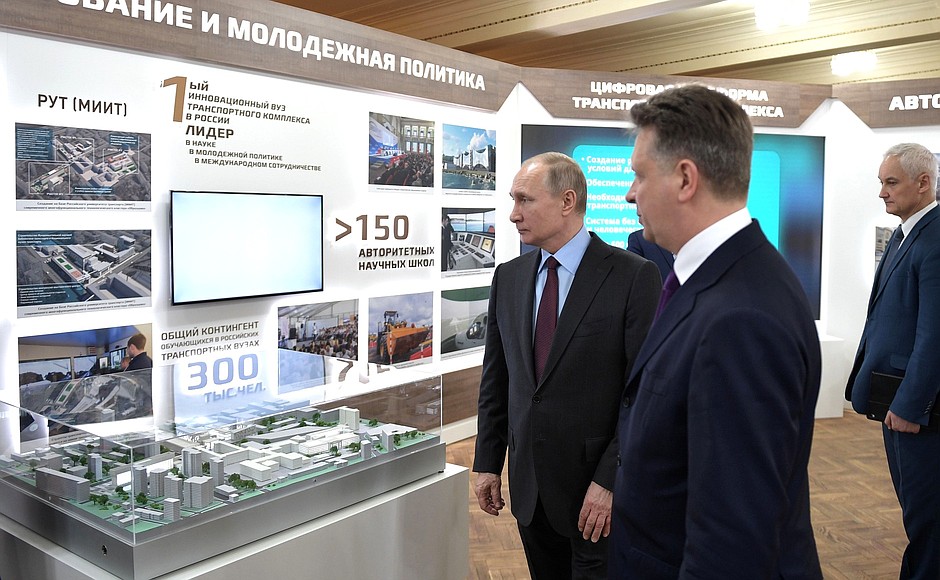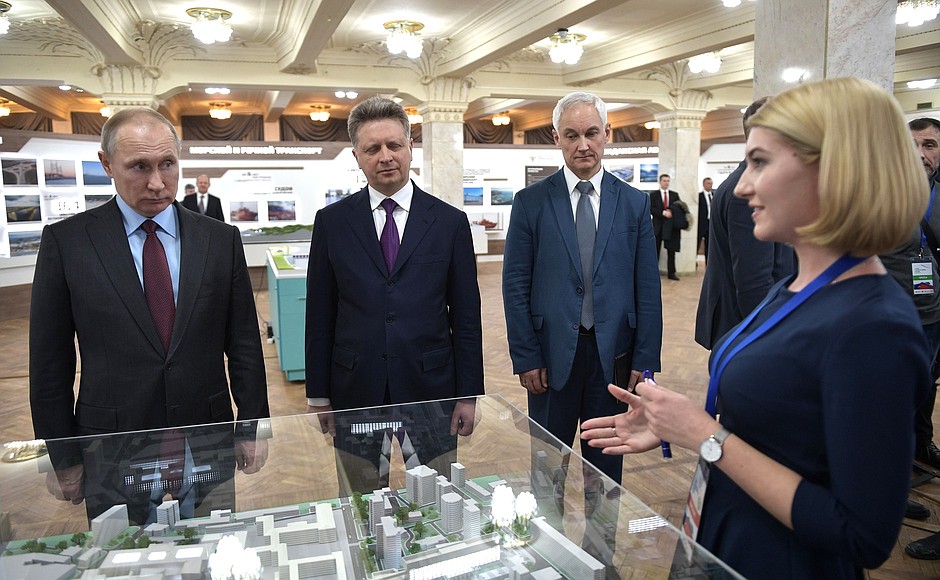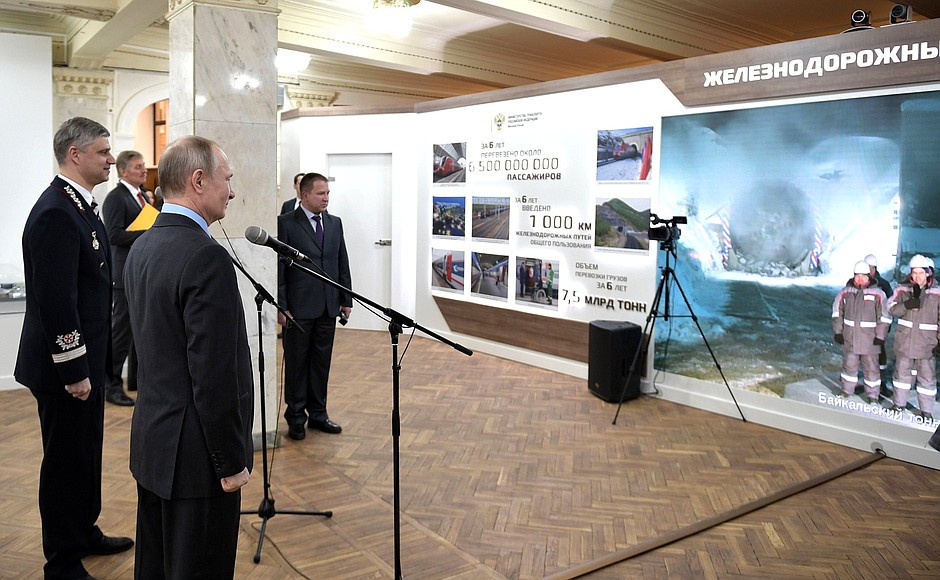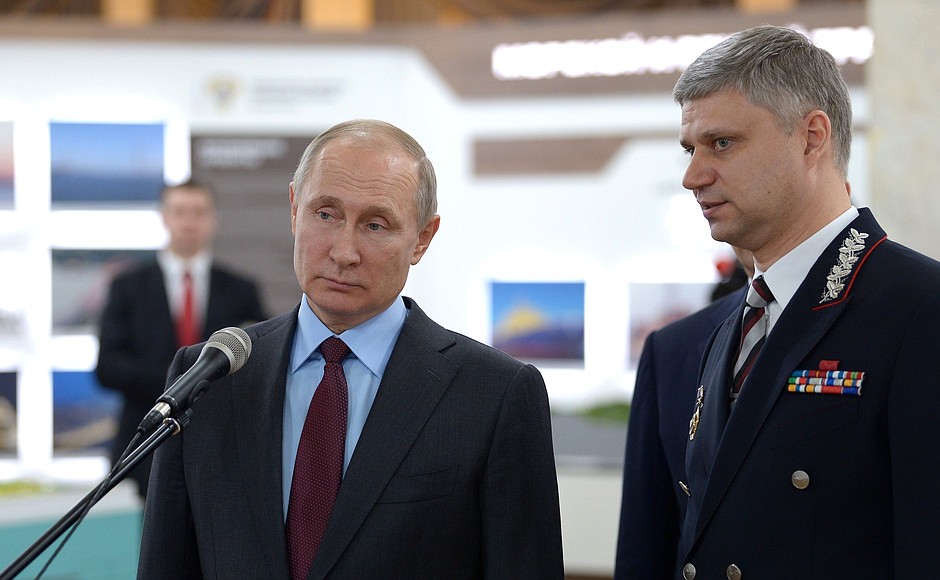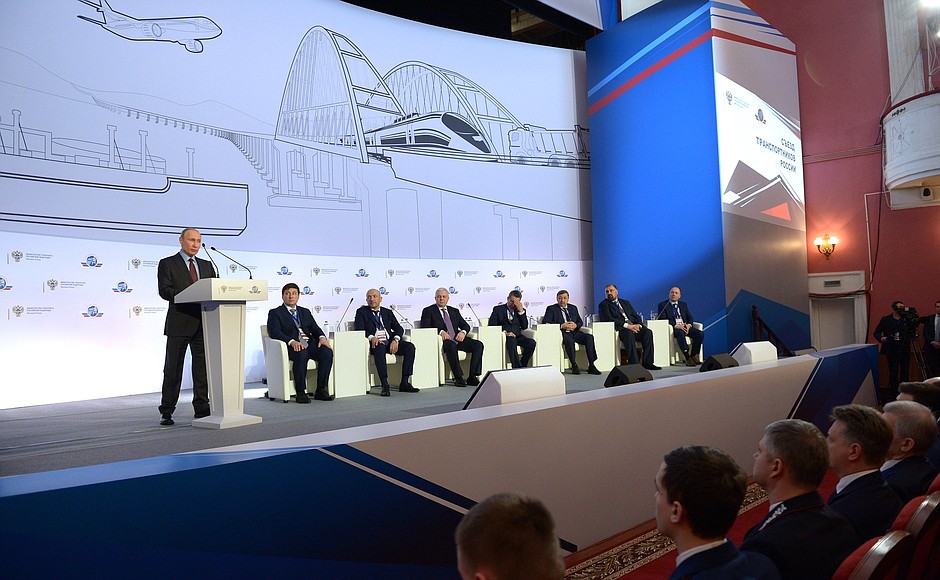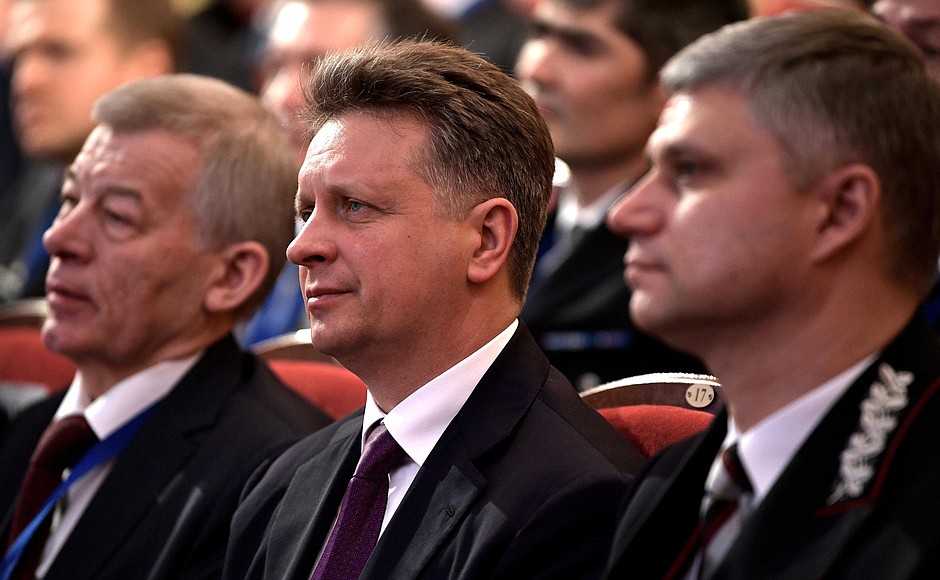Held once every five years, the Congress of Transport Workers of Russia is the main platform for discussing and analysing the industry’s performance and trends.
Before the plenary session, the President examined an exhibition of priority transport projects and took part in a video conference with a construction site for the Second Baikal Tunnel.
***
Speech at the plenary session of the Congress of Transport Workers of Russia
President of Russia Vladimir Putin: Good afternoon, colleagues, friends.
Thank you for inviting me to attend the Congress of Transport Workers. At the start, I would like to congratulate the Union of Transport Workers of Russia, the biggest industry association in the country, on its 15th anniversary. I would like to thank you for your active involvement in preparing decisions on the most important issues both for the industry and the country.
Your engaged approach to problems that face Russia is dictated by that special systemic role that the transport industry has played and, of course, will always play in the life of our large country. By linking cities, regions and territories, it ensures Russia’s spatial connectivity and serves as the basis for the development of the economy and the social sphere and for this country’s integration in the global economy.
Thanks to the work done by many generations, Russia has one of the biggest transport systems in the world, a system encompassing all modes of transport and accounting for about 6 percent of all jobs in the national economy.
Russian transport today is one of the most dynamic industries. According to last year’s results, 5.4 percent more freight and 8.9 percent more passengers were carried.
The transport industry’s balanced, steady development, along with improved working conditions and efforts to ensure the competitiveness of Russian carriers, represent the unconditional priority of our policy, a priority for the state, a source and foundation of national economic growth.
And, of course, transport companies themselves should work to increase their efficiency and labour productivity. This shores up their market positions and, critically, increases the wages and family well-being of their employees.
As you may be aware, a significant portion of the Address to the Federal Assembly, which outlines key long-term tasks and development goals, was devoted to integrated infrastructure development both in terms of improving living standards and providing new opportunities for the economy, business and the kinds of projects which set the technological trends that guide the industry’s development. I would also like to note that the Address was used to ask the Government to prepare a comprehensive plan for upgrading and expanding the entire transport infrastructure.
Digital technologies and services, which are being actively introduced in all spheres of life and have become a powerful factor of qualitative growth, must become a major source for the development of domestic transport. And today I heard about this at the exhibition on developing various transport solutions.
Already now, you can go online to check timetables and get directions, buy a ticket and track shipments. Digital solutions allow for significant advances in the development of multimodal or, as experts say, ”seamless“ shipping operations.
We need to use innovative technology to increase the efficiency of the industry, cut costs of carriers and customers, and improve passenger convenience and comfort. In particular, I am talking about using competitive, domestically produced software. I want to focus on this particularly. This is what all new projects should start with. It is imperative to focus on domestic production, especially as we have all it takes to do so.
All of this should give additional impetus to Russia’s transport system, and strengthen our country’s positions on the global market of shipping and logistics services.
Friends,
Automotive transport is one of the most popular modes of transportation. In terms of tonnage, almost 70 percent of cargo in Russia is hauled by road.
As I noted in the Address, we will almost double our spending on the country's roads in the next six years, allocating over 11 trillion rubles for these purposes. We will bring regional and local routes up to code. This is a daunting task, and you are well aware of it. We have largely brought federal motorways up to standard, but there are ten times more regional and local roads.
A large amount of private investment is needed to solve this task. And we will provide systemic support to investors who invest in infrastructure, we will launch new instruments for financing road construction such as infrastructure mortgages, and we will increase the appeal of road development projects by developing roadside territories.
And of course, new technologies and materials have to be used that will increase the quality and durability of roads, which translates into increased traffic safety. Life cycle contracts need also to be used more widely here, meaning that the contractor bears direct financial responsibility for the condition of roads throughout their term of service.
Alongside upgrading the country’s road network, we have to make vehicles more advanced and environmentally friendly. I would like to stress here how crucial it is not to unfairly overburden our companies. We have to offer a system of incentives that does the utmost to upgrade the vehicle fleet, which should be a natural, flexible and profitable process. I ask the Government to work out these issues with the business community. This is absolutely necessary if we want to develop energetically and to increase our competitiveness.
One more important issue. Domestic haulers often say that they operate in Russia in unequal conditions compared to foreign companies.
I ask the Government together with Haulers’ Union and other hauler organisations to analyse the situation one more time. We have been dealing with that regularly, by the way, yet the issues have not been fully resolved. Changes should be prepared in this regard, too.
Next. Last November, we met with many of the attendees at the Railway Congress where the operation of Russia’s railways and key tasks for the future were discussed.
Let me stress again that we must develop the logistics of railway transportation, increase train speed, clear “bottlenecks” including approaches to the country’s sea ports, and raise the capacity of Russian railroads, including transit container carrying.
Quite recently, right before our meeting started, another important step was made to remove one of the major obstacles impeding the speed and volume of transportation on the Baikal-Amur Mainline. The second Baikal tunnel has been dug. This a great achievement, a cause for celebration for those who made it possible.
As early as next year, there will be two tracks for railway traffic across the Baikal Range. The traffic capacity of the section, and of the entire mainline, will increase dramatically.
A separate and very important topic for people is the development of the commuter railway system and the renewal of rolling stock.
Let me remind you that the necessary decisions have already been made at the federal level, and the responsibilities of the Federation and the regions have been delineated. Commuter railway carriers enjoy zero tariff for the use of the infrastructure: VAT has been suspended for this transport until 2030. We made our way towards these decisions gradually, from year to year, based on real opportunities and needs.
I would ask the leaders of the regions to take a very responsible approach to financing the commuter railway systems, to consider its social significance, as well as its role in ensuring the involvement of small towns and rural areas in the overall economic, social and cultural space of the country, in the development of tourism and in the creation of a modern, highly mobile lifestyle in general. This is one of the key tasks – to increase the mobility of the population and labour resources.
Further. Russia not only has one of the longest rail networks, but also a unique geography for access to the world’s waterways. As mentioned, in recent years we have achieved a significant increase in the capacity of Russian seaports. The total capacity is over one billion tonnes, compared to only 600 million tonnes in the Soviet era and only 300 million tonnes in the early 2000s. Now we have more than a billion.
We will continue to develop large logistics centres in the Baltic and Black seas, the Pacific Ocean and the Arctic basins.
A huge reserve for the growth of transport – especially large and heavy cargo – is represented by the development of inland waterways. We have launched measures to strengthen river infrastructure, hydraulic facilities and dredge riverbeds.
I would like draw the Government’s attention to this: all plans should be implemented in full. This directly influences the structure of freight turnover and the launch of new investment projects on river transport.
And a few more things. Recently, we marked a landmark date – the 95th anniversary of civilian aviation.
After a difficult, very difficult period in the 1990s, this area is steadily gaining momentum. Over one hundred airports have been upgraded, and more than 60 runways have been rebuilt. For the first time since the Soviet Union collapsed, new airports have been built, such as Sabetta in the Arctic and Platov in Rostov-on-Don.
Air traffic has grown almost five times since the early 2000s. As of the end of last year, the number of passengers carried by Russian airlines surpassed 105 million people for the first time. I sincerely congratulate them on this undisputed success.
We will continue renovating and developing the network of regional airports as well as extending the list of direct inter-regional flights, especially long haul flights to remote areas in the north, Siberia and the Far East.
It is important that the development of Russian airports go hand in hand with an increase in the number of Russian aircraft: high-quality, efficient and reliable, including small and medium aircraft of 9 to 65 seats.
I am counting on airlines and other businesses in the industry to provide concrete proposals for necessary support measures. Although many of them probably know that we have allocated resources specifically to upgrade the aircraft fleet. We have done so intentionally, even putting reserve funds toward it.
Friends, the accelerated development of the national transport system and the use of advanced technology require new specialists and additional training for those already employed in the industry.
I know that personnel and training are a focus in the transport industry. It is not by chance that we are meeting at the industry’s main university: the Russian University of Transport.
We must consistently upgrade the facilities and resources of industry-related education and research, and launch new training programmes in the most advanced and popular areas of personnel training. We discussed that at the exhibition.
The government, the regions and the entire professional education system must be based, first of all, on the demands of transport companies and take into account their proposals in this work.
In conclusion, I would like to wish success and all the very best to everyone – from those who are just starting out as transport workers, to industry veterans.
Colleagues, there is no doubt that the development of the transport system and infrastructure is one of our main tasks for the next six, ten, fifteen years. Without a doubt, this is an area our country must work hard on in the near term, because our economy’s competitiveness depends on it.
I wish you success. Thank you very much for your attention.
